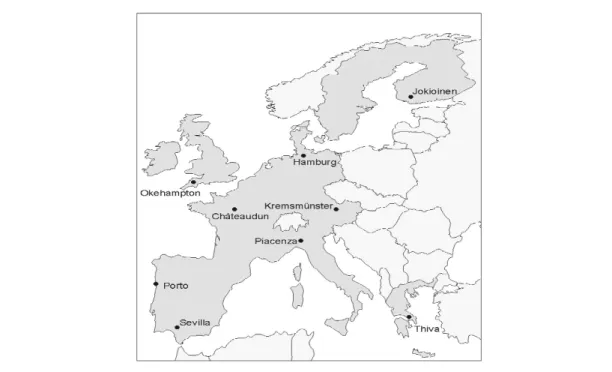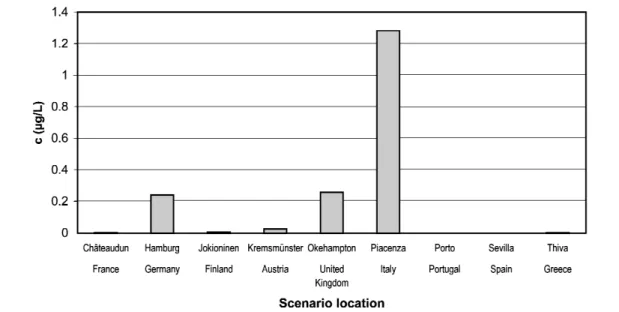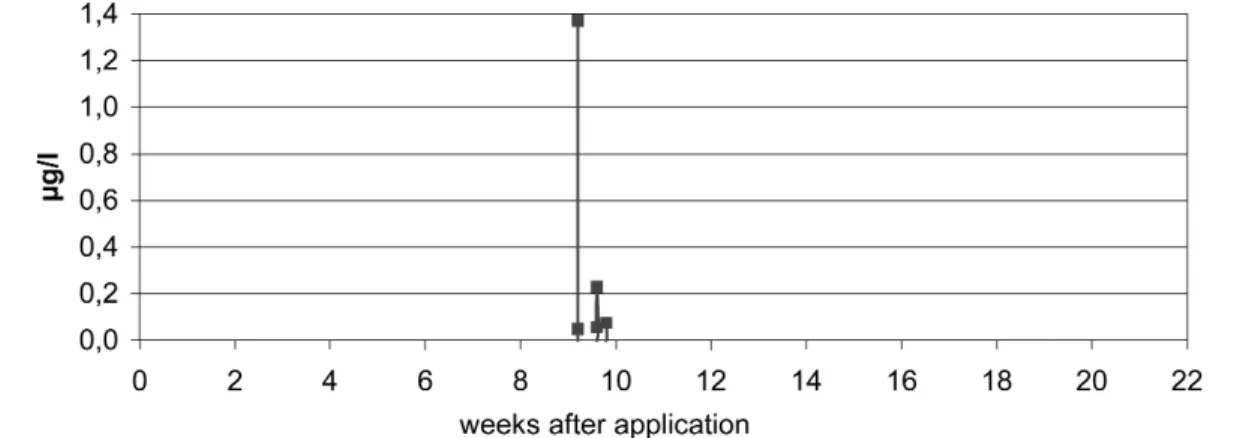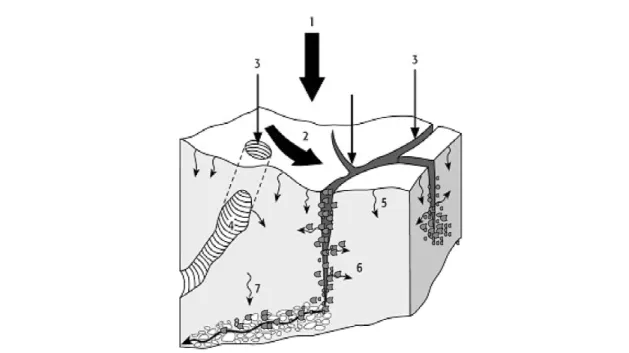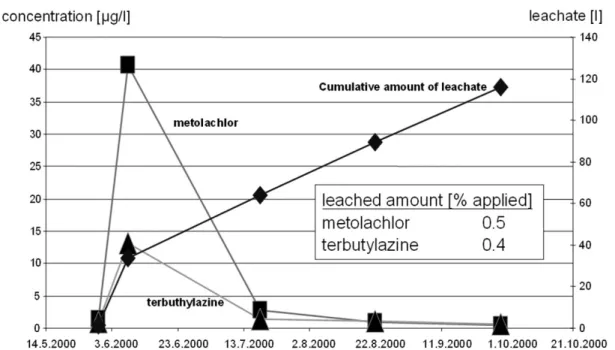doi:10.1351/pac200678051081
© 2006 IUPAC
Prediction of leaching and groundwater contamination by pesticides*
Werner Kördel
‡and Michael Klein
Fraunhofer-Institute Molecular Biology and Applied Ecology, D-57392 Schmallenberg, Germany
Abstract: Herein, we describe how pesticide leaching is assessed in Europe in order to fulfill EU Directive 91/414. The assessment schemes were developed to protect groundwater from unacceptable effects caused by pesticide use. They presently focus on chromatographic flow processes, which are dominant in sandy soils. Nevertheless, important regions in Europe are characterized by structured soils where transport through macropores is most relevant.
Comparison of parallel field studies with isoproturon performed in sandy and silty soils showed that maximum concentration in the structured soil at a soil depth of 1 m may exceed respective concentrations in sandy soils by a factor of 60. Similar results were obtained by lysimeter studies using silty soil cores with maximum concentration of 40 µg/l at the soil bot- tom. These results demonstrate that preferential flow is more the rule than the exception in well-structured fine-textured soils, and pesticide losses via macropore flow may exceed losses via matrix transport considerably. All present information available for macropore flow suggest the need for greater regional assessments. Other recommendations include analysis of the influence of different soil management practices on the formation of macro- pores.
Keywords: soil; computer models; pesticides; analytical chemistry; flow processes; transport;
macropores.
INTRODUCTION
As a consequence of the implementation of EU Directive 91/414 [1], all pesticides have to be subjected to an authorization procedure. The condition for issue of an authorization is that the product or its residues do not exert unacceptable effects on human and animal health or on surface water and ground- water. The prediction of leaching and groundwater contamination by various methods, experimental as well as computer-based modeling, are used as key instruments to fulfill the requirements of the Directive.
However, the leaching of pollutants to groundwater is a rather complex process influenced by many variables such as meteorological parameters (e.g., rainfall and temperature), soil properties (par- ticle size distribution, organic carbon content), and physical-chemical data of the chemical (e.g., water solubility, vapor pressure). Lastly, biodegradability and sorption, which are dependent on both solute chemistry and soil properties, play usually decisive roles for organic compounds when predicting groundwater contamination.
*Paper presented at the 40thIUPAC Congress, Beijing, China, 14–19 August 2005. Other presentations are published in this issue, pp. 889–1090.
‡Corresponding author
Based on this knowledge, standard decision trees have been developed in the European Union (EU) that start with simple laboratory measurements on sorption and degradation of the pesticide, con- tinue with standard modeling approaches using standardized worst-case scenarios developed by the FOCUS group (FOCUS: FOrum for the Coordination of Pesticide Fate models and their USe [10]) and end with more sophisticated modeling and/or extensive outdoor studies (lysimeter, field leaching stud- ies) to assess the leaching potential.
This traditional concept mainly focuses on chromatographic flow processes that are dominant in sandy soils. For these soil types, the computer models work rather well, including meaningful adapta- tion of outdoor studies to other climatic conditions based on modeling.
This traditional concept focuses on chromatographic flow processes that are dominant in sandy soils. For these soil types, the computer models work rather well and allow meaningful adaptation of outdoor studies to other climatic conditions based on modeling (see, e.g., [5–9]). However, chromato- graphic transport through the soil matrix system is not the only process that has to be considered when predicting the leaching of chemicals. Especially in structured soils (silty and/or clay soils) preferential flow through macropores formed by shrinking cracks and fissures becomes the dominant leaching process [2]. As a consequence, in structured soils the chemical properties sorption and degradation do not control the transport of chemicals through the soil core anymore. Instead, even substances with dif- ferent properties are transported in a similar manner, and it becomes mainly dependent on local soil and climate conditions to what extent they are transported to deeper soil layers. Finally, the mass flow ob- served is often significantly higher than for the chromatographic flow in sandy soils.
This paper gives some information about traditional and recently developed methods that can be used to analyze leaching processes in sandy, but also in structured soil types.
PREDICTION OF CHROMATOGRAPHIC FLOW THROUGH THE SOIL MATRIX
Presently, the estimation of pesticide leaching to protect groundwater is not fully harmonized at the member state level in the EU. However, the principles of the national decision trees follow similar ideas by starting with simple measurements followed by computer modeling and field testing as summarized in Fig. 1.
The initial registration process always begins with standard laboratory measurements on leaching and degradation according to Organization for Economic Cooperation and Development (OECD) guidelines. Depending on this experimental data, further work has to be done by performing computer simulations with predefined scenarios and Europe-wide accepted computer models. An excellent overview of these models and scenarios, including detailed advice for input parameter settings, is sum- marized by FOCUS [10]. In this report, nine realistic worst-case groundwater scenarios have been de- fined, which collectively represent agriculture in the EU (Fig. 2). Soil properties and weather data have been defined for all scenarios and have been summarized in tables. Crop information has also been de- fined for each scenario, including 5 crops which can be grown across the whole EU, and a further 20 which are particular to specific parts of the EU.
Additionally, input files corresponding to all nine scenarios have been developed for use with the chromatographic flow models PEARL, PELMO, and PRZM. The weather data files developed for these models include irrigation in the case of four of the scenarios, and also include the option of making ap- plications every year, every other year, or every third year.
Examples of computer-generated simulations of worst-case scenarios are presented in Fig. 3 with typical application pattern and pesticide properties of isoproturon. The usual trend is that Hamburg, Okehampton, and Piacenza provide the highest results for the models, whilst Porto and Sevilla provide the lowest results. For the example substance, the range of 80thpercentile concentrations for the nine scenarios was approximately two orders of magnitude, which is typical for substances with a leaching behavior leading to a concentration range of 0.01–10 µg/l.
Fig. 2 Nine groundwater scenarios representing agriculture in the EU.
If based on the results of the initial modeling level B (see Fig. 1), no authorization can be given.
Additional information on the pesticide behavior in soil can be used to refine the standard parameters and to repeat the simulations with more appropriate input data (see Fig. 1, level C1). Examples for pos- sible refinements are the consideration of additional processes such as subsurface degradation, long- term sorption, photolysis, or volatilization, which were not used in the initial modeling step B. Another way of improving the initial modeling step could be the definition of pesticide- and crop-specific sce- narios by overlapping soil maps, the respective climate information and maps showing the intended use area and additional agricultural census data. Geographic information systems (GIS) are useful instru- ments for these analyses. By considering additional hydro-geological information, the proposed GIS analysis could also demonstrate that in some parts of the pesticide use, area groundwater contamina- tions can be totally excluded (see Fig. 1, level C2).
Finally, extensive outdoor studies could follow the initial modeling step, to address potential leaching issues under field or lysimeter conditions. Photographs of such an outdoor study (depth 1 m, surface 1 m2) with isoproturon in a sandy soil are presented in Photos 1 and 2.
These lysimeters are taken from a field as undisturbed soil cores. The technique is described in detail by Hassink and Kördel [11]. These undisturbed soil cores are transferred to the lysimeter plant at the institute. The lysimeter itself and the surrounding area are cultivated according to normal agricul- tural practice. For experiments with isoproturon, the area was cultivated with winter wheat and iso- proturon was sprayed as 14C-labelled compound in the autumn. Leachate of the lysimeters was sampled on regular intervals and analyzed for 14C content, parent compound, and metabolites. At the lysimeter plant, there is a permanent recording of the climatic parameters. By using a loamy sand, the results show that chromatographic flow was the dominant transport process leading to a sharp peak of iso- proturon in the leachate about two months after application of the pesticide. However, the annual aver- age concentration of isoproturon was below 0.1 µg/l, confirming that the standard FOCUS modeling scenarios are representative of realistic worst-case situations in this instance.
Fig. 3 Calculated 80thpercentile of the annual average concentration in leachate (FOCUS PELMO).
The lysimeters represent only a small part (1 m2) of a field, and the undisturbed soil core is placed on a sieve plate, so the hydraulic connection to the subsoil is cut. In order to test if lysimeter results are representative of actual field conditions, isoproturon was applied on a drained field with comparable soil properties. In both experiments, application was in late autumn on winter wheat. As summarized in Fig. 4, the results show that isoproturon appeared in the drain effluent only in early spring. The respec- tive annual average concentration in the percolate was again below 0.1 µg/l.
Photo 1 Lysimeter experiment with isoproturon (shortly after application).
Photo 2 Lysimeter experiment with isoproturon (fully developed crop).
Photo 3 Colored macropores, silty soil, 90 cm depth. Photo 4 Colored soil profile of a silty soil.
LEACHING THROUGH MACROPORES
As described above, preferential flow becomes important in structured soils (silty and/or clay soils) where stable macropores are formed by shrinking cracks and fissures. Formation of macropores often starts at nonhomogeneous microregions, e.g., humus particles, small stones, or tap roots. Formation and stability depends on the water regime of the soil, which is strongly influenced by weather conditions, plant cover, and management practices. In silty soils, biopores are most important [12,13].
The transport of chemicals through macropores is highly dependent on a variety of factors that show a wide range of variability. Chromatographic flow transport is governed mainly by sorption and degradation only. However, the extent of preferential flow depends on the abundance and stability of the different types of macropores, such as soil texture, organic matter content, actual soil humidity, cul- tivation practices, and previous crops, to mention only a few. Of similar importance are weather phe- nomena, particularly frequency, intensity, and time-regime of the rainfall, and further factors impacting on the percolation such as irrigation and hydraulic conductivity of the horizon beneath the macropores.
Solute transport via macropores is illustrated by Fig. 5. The schematics drawing shows an earth- worm channel and cracks. During a heavy rainfall, the infiltration capacity of the soil surface may be exceeded. Then, surface and pore water will flow through these macropores. As macropores have a larger diameter, solute flow is fast, thus strongly reducing the importance of distribution processes be- tween migrating water and the soil matrix. This quick water flux can continue during the heavy rainfall period if the macropore can drain continuously. Therefore, the macropore has to end on very permeable subsoil or in the direct neighborhood of a drain pipe (open-ended macropore). In this case, substances symbolized by the small red objects will be transported toward groundwater in the quick solute flux. If the macropore ends within a homogenous subsoil, the fast solute flux will be followed by matrix flux.
This means solute and thus substance transport is controlled by the relatively slow matrix flux (dead- ended macropores), leading to so-called hot spots at the end of the macropores.
Fig. 4 Isoproturon discharge by drain effluents in a sandy soil (autumn application).
To investigate the differences in discharge, isoproturon was applied on a sandy soil and on a silty soil (about 75 % silt), which contained macropores (holes of earthworms and of decaying roots). This field was also tile-drained, so drain effluents could be easily collected. Figure 6 shows the isoproturon discharge by drain effluents. The isoproturon pattern in the drain effluent is totally different compared to the sandy soil. The first heavy rain event after application leads to the highest concentration of iso- proturon in the leachate with a peak concentration of 60 µg/l. Subsequent heavy rainfalls during the winter lead to a peaking, however, with decreasing concentrations. The annual mean isoproturon con- centration in drain effluents was significantly higher than 0.1 µg/l.
Fig. 5 Comparison of open- and dead-ended macropores.
Fig. 6 Isoproturon discharge by drain effluents in a loamy soil (autumn application).
To study macropore transport in more detail, lysimeters were filled with undisturbed soil cores of this soil. The lysimeters were equipped with sieve plates at the bottom. About half of these sieve plates were covered by suction plates; meaning half of the area leachate was sampled via suction plates and the other part via free drainage through the sieve plate. Metolachlor and terbutylazine were applied in spring on bare soil.
Figure 7 shows the pesticide concentrations in the leachate for the free drainage condition.
Typical for macropore transport is the high concentration in leachate after the first heavy rainfall and application, which leads to preferential flow, revealing metolachlor concentrations of 40µg/l and ter- butylazine concentrations of 13 µg/l. During late spring and summer, there were further rain events that lead to leachate formation, however, no heavy rainfalls leaching to macropore transport.
The herbicide concentrations in the samples collected by the suction plates (Fig. 8) show a quite different pattern. The concentrations are much lower as suction plates disrupt the rapid solute flux by macropores. Suction plates have a relatively fine membrane. Therefore, solute flux through this mem- brane is relatively slow and is comparable to solute movement in sandy soils. This shows that suction plates adequately simulate the conditions in the surroundings of dead-ended macropores (see Fig. 5).
Fig. 7 PSM concentrations in leachate after spring application on a silty soil—free draining.
In order to visualize macropore transport through the soil core, a dye was applied to a lysimeter and additionally to a field plot where the lysimeter was taken from. The dye application was followed by a short irrigation. The undisturbed soil core of the lysimeter was horizontally cut into layers of 10 cm each. Photo 3 (see p. 1085) shows the top view on the soil layer of 90–100 cm depth. In this layer, col- ored macropores (earthworm channels can be clearly seen, elucidating the fast solute flux, including the dye) through this macropore
Photo 4 (see p. 1085) demonstrates results of a plot experiment at the site where the lysimeter core was also taken. Macropores through which the dye was transported during a short irrigation event through the soil profile are visualized.
The importance of macropore transport, as it relates to pesticides, has been demonstrated by Kördel et al. [2] who collected published data on pesticides losses caused by preferential flow. They re- port losses of 0.22 and 0.135 % of the applied amount for atrazine and isproturone, respectively, with ranges of 0.02 to 3.6 % (atrazine, n = 24) and 0.002 to 2.5 % (isoproturone n = 24). These values also clearly demonstrate the high variability of macropore transport and its dependency on many environ- mental conditions.
CONCLUSIONS
Presently, the standard assessment of the leaching potential of pesticides in Europe is based on the chro- matographic flow through the soil matrix, which is the dominant process in sandy soils. Testing and as- sessment strategies have been well studied and validated in this type of soils. However, in well-struc- tured and fine-textured soils, preferential flow is more the rule than the exception. Pesticide losses via macropore flow may exceed losses via matrix transport considerably. Pesticide transport through macropores depends on many site-specific factors. Soil moisture and precipitation/irrigation regime may strongly influence the amount of pesticide losses. Also, soil management practices, the amount and Fig. 8 Pesticide concentrations in leachate after spring application on a silty soil—draining by suction plates.
stability of macropores, and the porosity of the subsoil where macropores are ending determine solute transport. However, though substance properties are less important in structured soils compared to sandy soils, pesticide-leaching transport still increases with increasing persistence and inherent mobil- ity.
Pesticide transport by macropores cannot generally be predicted by laboratory test systems or by simulation experiments like lysimeters. It mainly depends on soil properties (soil that will form stable macropores) and on the permeability of the subsoil. These properties can be mapped by geographical information systems. Therefore, taking preferential flow into consideration, mobile and semi-mobile pesticides should not be applied in those areas—leading to a regional or site-specific assessment.
REFERENCES
1. Commission of the European Communities. Council Directive 91/414/EEC concerning the plac- ing of plant protection products on the market. Official Journal of the European Communities No.
L 230 (1991).
2. W. Kördel, H. Egli, M. Klein. Pure Appl. Chem. Submitted for publication.
3. M. Vanclooster, J. J. T. I. Boesten, M. Trevisan, C. D. Brown, E. Capri, O. M. Eklo, B.
Gottesbüren, V. Gouy, A. M. A. van der Linden. Agric. Water Manage. 44, 1 (2000).
4. N. J. Jarvis. The MACRO Model (Version 3.1). Technical description and sample simulations.
Reports and Dissert. 19, Department of Soil Sciences, Swedish University of Agricultural Science, Uppsala, Sweden (1994).
5. M. Klein, M. Müller, M. Dust, G. Görlitz, B. Gottesbüren, J. Hassink, R. Kolskowski, R. Kubiak, H. Resseller, H. Schäfer, B. Stein, H. Vereecken. Chemosphere 35, 2563 (1997).
6. M. Vanclooster, J. J. T. I. Boesten, M. Trevisan, C. D. Brown, E. Capri, O. M. Eklo, B.
Gottesbüren, V. Gouy, A. M. A. van der Linden. Agric. Water Manage. 44, 1 (2000).
7. A. Tiktak. Agric. Water Manage. 44, 119 (2000).
8. M. Klein, J. Hosang, H. Schäfer, B. Erzgräber, H. Resseler. Agric. Water Manage. 44, 263 (2000).
9. R. Francaviglia, E. Capri, M. Klein, J. Hosang, K. Aden, M. Trevisan, G. Errera. Agric. Water Manage. 44, 135 (2000).
10. FOCUS. “FOCUS groundwater scenarios in the EU review of active substances”, Report of the FOCUS Groundwater Scenarios Workgroup, EC Document Reference Sanco/321/2000, rev. 2 (2000).
11. J. Hassink, W. Kördel. “Transport and fate of pesticides in outdoor lysimeters”, in Pesticide/Soil interactions. Some Current Research Methods, J. Cornejo, P. Jamet (Eds.), pp. 297–304, INRA Edition, Paris (2000).
12. W. E. Eduards, M. J. Shipitalo, W. A. Dick, L. B. Owens. Soil Sci. Soc. Am. J. 56, 52 (1992).
13. R. G. Stehouwer, A. Dick, S. J. Traina. J. Environ. Qual. 25, 227 (1996).
